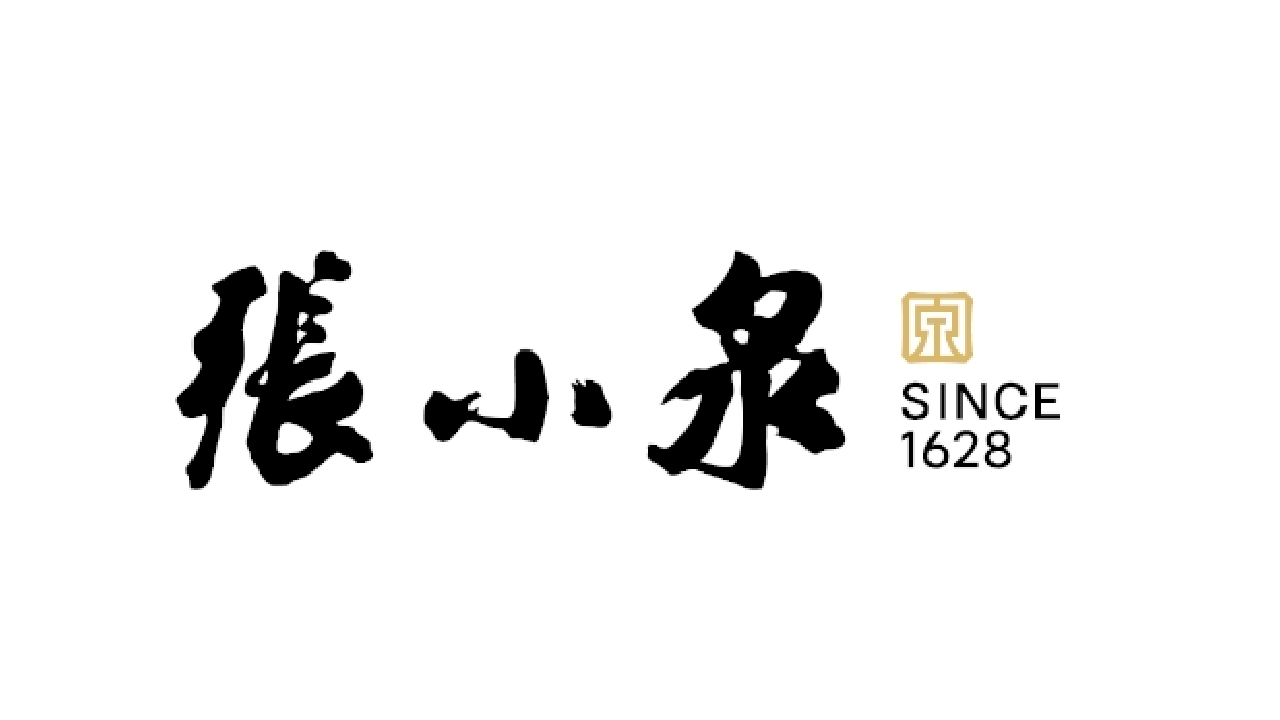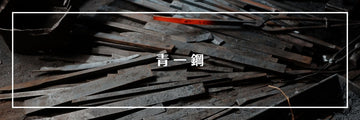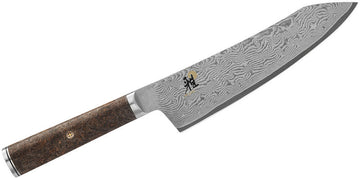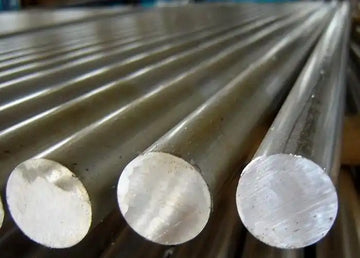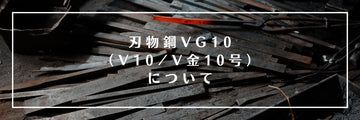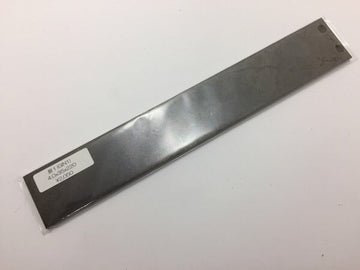Blue Steel #1 (Aogami 1) represents the upper echelon of Japanese knife steels produced by Hitachi Metals (now PROTERIAL). Prized for its exceptional edge retention and hardness, this high-performance steel is favored by professional chefs and serious enthusiasts who demand the absolute best in cutting performance and are willing to accept the meticulous maintenance it requires.

What Blue Steel 1 Is Made Of
Blue Steel 1 features a carefully formulated composition that prioritizes hardness and wear resistance:
- Carbon: 1.25-1.35% - Higher than Blue Steel 2, providing maximum hardness and edge stability
- Chromium: 0.30-0.50% - Offers modest corrosion resistance compared to non-alloyed steels
- Tungsten: 1.50-2.00% - Forms hard carbides that dramatically improve wear resistance
- Silicon: 0.10-0.20% - Strengthens the steel matrix
- Manganese: 0.20-0.30% - Enhances hardenability during heat treatment
There are even subtle variations within Blue Steel 1 itself: Aogami 1A has slightly higher carbon for increased hardness (used for specialized cutting applications), while Aogami 1B contains slightly less carbon for improved toughness (used for more general-purpose blades).
When properly heat treated, this composition creates a fine martensitic structure with well-distributed tungsten and chromium carbides that provide exceptional edge retention without sacrificing the ability to take an extremely sharp edge.
How Blue Steel 1 Performs In The Kitchen
Hardness And Toughness
Blue Steel 1 achieves impressive hardness levels of 64-65 HRC on the Rockwell scale, making it one of the hardest kitchen knife steels available. This extreme hardness allows it to maintain its edge for significantly longer periods than most other steels, including its sibling Blue Steel 2.
The trade-off for this exceptional hardness is reduced toughness compared to lower-carbon steels. Blue Steel 1 is more prone to chipping if subjected to lateral forces, bone contact, or improper cutting technique. This makes it somewhat less forgiving than Blue Steel 2 or White Steel 2, requiring more precise knife skills and careful use.
For professional chefs with refined technique, this balance of extreme hardness with acceptable toughness creates a knife that excels in precision tasks where edge retention is paramount and proper technique can mitigate the risks of chipping.
Sharpness And Edge Retention
Blue Steel 1's greatest strength is its combination of extreme sharpness with outstanding edge retention. The fine grain structure and hard carbides allow it to take a razor-sharp edge capable of the most delicate tasks, such as slicing paper-thin sashimi or performing precise garnish work.
What truly sets it apart is how long this edge lasts. In professional kitchens, Blue Steel 1 knives maintain their sharpness through extensive prep work, often requiring 30-40% less frequent sharpening than comparable White Steel knives. The tungsten carbides provide exceptional resistance to abrasion, allowing the edge to withstand repeated contact with cutting boards without significant degradation.
When it eventually does require sharpening, Blue Steel 1 is somewhat more challenging to sharpen than White Steel or Blue Steel 2 due to those same hard carbides. However, skilled sharpeners can still achieve exceptional results, and many professionals find the trade-off for extended edge life well worth the additional effort.
Reactivity And Care Requirements
Like all carbon steels, Blue Steel 1 is reactive and will rust if not properly maintained. While the chromium content provides slightly better corrosion resistance than White Steel, it remains far from stainless and requires diligent care:
- Immediate cleaning and drying after use, especially with acidic ingredients
- Regular oiling with food-safe oil (camellia oil is traditional)
- Careful storage in dry conditions, ideally in a wooden sheath (saya)
- Prompt attention to any rust spots that develop
Many users develop a relationship with their Blue Steel 1 knives, appreciating how the patina develops over time and reflects their unique cutting history. This patina also provides some additional protection against corrosion while adding character to the knife.
Blue Steel 1 Applications In Kitchen Knives
Ideal Kitchen Applications
Blue Steel 1's exceptional hardness and edge retention make it particularly well-suited for specialized cutting tasks:
- Yanagiba/Sujihiki: Long, single-bevel knives designed for precise slicing of raw fish, where the extreme sharpness and edge retention excel
- Gyuto: High-end chef's knives that maintain their edge through extensive professional use
- Nakiri/Usuba: Vegetable knives that benefit from the clean cutting ability that preserves cell structure
The steel is particularly revered in traditional Japanese cuisine, where approximately 70% of Michelin-starred sushi chefs prefer Blue Steel 1 for tasks requiring absolute precision, such as octopus scoring (tako-wari).
Market Position
Blue Steel 1 knives occupy the premium segment of the market, typically priced from $235 up to $2,500 or more for honyaki (single-piece) constructions. This positions them as professional tools and serious investments for dedicated enthusiasts.
These knives are crafted by skilled artisans who understand how to properly heat treat this demanding steel to bring out its best qualities. The additional craftsmanship required explains part of the premium pricing compared to Blue Steel 2 or stainless alternatives.
Comparison With Other Kitchen Knife Steels
Blue Steel 1 vs. Blue Steel 2
Blue Steel 1 contains more carbon (1.25-1.35%) than Blue Steel 2 (1.05-1.15%) and typically more tungsten as well. This results in higher hardness (64-65 HRC vs. 62-63 HRC) and approximately 20-25% better edge retention. However, Blue Steel 2 offers about 30% better toughness and chip resistance, along with somewhat easier sharpening. Professional chefs often choose Blue Steel 1 for specialized precision tasks, while preferring Blue Steel 2 for general-purpose knives that see a wider variety of cutting tasks.
Blue Steel 1 vs. White Steel 1
Both steels share similar carbon content (1.25-1.35%), but Blue Steel 1 contains tungsten and chromium that White Steel 1 lacks. This gives Blue Steel 1 approximately 35-40% better edge retention and moderately improved corrosion resistance. White Steel 1 can take a marginally keener edge and is easier to sharpen due to its simpler composition. Choose Blue Steel 1 for edge longevity; choose White Steel 1 for the ultimate in pure sharpness when frequent resharpening isn't a concern.
Blue Steel 1 vs. Blue Steel Super
Blue Steel Super contains slightly more carbon than Blue Steel 1 (1.40-1.50% vs. 1.25-1.35%) and adds molybdenum and vanadium that Blue Steel 1 lacks. While both achieve similar hardness ranges (64-65 HRC), Blue Super offers about 15-20% better edge retention thanks to its more complex carbide structure. However, Blue Super is more difficult to sharpen and typically more expensive. Blue Steel 1 represents an excellent balance of premium performance without the extreme specialization of Blue Super.
Taking Care Of Blue Steel 1 Knives
Basic Maintenance
Caring for Blue Steel 1 requires diligence but follows a straightforward routine:
- Wipe the blade clean during use, especially when cutting acidic foods
- Hand wash with mild soap after use (never put in a dishwasher)
- Dry thoroughly immediately after washing
- Apply a light coat of camellia oil or food-grade mineral oil for storage
- Store in a dry place, ideally in a wooden sheath that allows air circulation
Many professional chefs keep a dedicated towel nearby when using their Blue Steel 1 knives, wiping the blade clean between different ingredients to prevent reactivity and maintain cleanliness.
Sharpening Recommendations
When it comes time to sharpen Blue Steel 1, follow these guidelines:
- Begin with medium grit stones (1000-2000) to establish the edge
- Progress to fine stones (4000-6000) for refining
- Consider finishing with an extra-fine stone (8000+) or strop for specialized applications
- Apply slightly more pressure than you would with White Steel, but maintain proper angles
While Blue Steel 1 requires more effort to sharpen than simpler steels, it responds well to proper technique and rewards the skilled sharpener with exceptional performance.
Conclusion
Blue Steel 1 represents one of the pinnacles of Japanese knife steel technology. Its carefully balanced composition delivers exceptional edge retention and hardness while still allowing for the extreme sharpness that Japanese knives are known for.
While it demands more careful use and maintenance than many alternatives, the performance benefits make it worth the effort for those with the skill to use it properly. For professional chefs and serious enthusiasts who prioritize cutting performance above convenience, Blue Steel 1 offers a premium experience that few other steels can match.
In a world increasingly focused on convenience and low maintenance, Blue Steel 1 stands as a reminder that the pursuit of performance sometimes requires commitment and care. For those willing to make that investment, it delivers a cutting experience that transforms cooking from a chore into an art.
Here are the question-and-answer pairs in the requested format:
How is blue steel made?
Blue Steel (Aogami) is made by Hitachi Metals in Japan through a process where high-purity iron is combined with precise amounts of carbon (1.05-1.35%), tungsten (1.0-2.0%), and chromium (0.2-0.5%). The steel is heated to approximately 800°C, quenched in oil or water, then tempered at 160-230°C to relieve internal stress while maintaining hardness. The name "Blue Steel" comes from the blue paper used to wrap the raw steel ingots.
What is blue steel made of?
Blue Steel is made of high-carbon steel with strategic alloying elements: 1.05-1.35% carbon (varies by type), 0.2-0.5% chromium for mild corrosion resistance, 1.0-2.0% tungsten for wear resistance and edge retention, plus small amounts of manganese (0.2-0.3%) and silicon (0.1-0.2%). Blue Super also contains molybdenum and vanadium. These elements create hard carbides in the steel matrix that enhance cutting performance.
Is blue steel stronger than steel?
Blue Steel isn't "stronger" than generic steel but is significantly harder (62-65 HRC) than most standard steels. This hardness enables superior edge retention and cutting ability, though it has less tensile strength and toughness than many structural steels. Blue Steel excels specifically in hardness and wear resistance—properties optimized for cutting tools rather than structural applications where different strength metrics matter.
Does blue steel rust easily?
Yes, Blue Steel rusts relatively easily despite containing small amounts of chromium. It's a carbon steel that requires vigilant maintenance: wipe clean during use, hand wash after use, dry immediately and thoroughly, and regularly apply food-grade oil. While it develops a protective patina that provides some resistance, it remains reactive to moisture, acids, and salts compared to stainless steels.
What grade is blue steel?
Blue Steel comes in three specific variants from Hitachi: Blue Steel #1 (highest carbon at 1.25-1.35%), Blue Steel #2 (medium carbon at 1.05-1.15%), and Blue Super (highest alloy content with added molybdenum and vanadium). These aren't "grades" in a hierarchical sense—each has specific applications where it excels. They're premium specialized tool steels rather than standard graded steels.
Is Japanese blue steel good?
Japanese Blue Steel is excellent for high-performance kitchen knives, offering exceptional edge retention, sharpness, and wear resistance. Professional chefs prize it for its cutting performance, though it requires diligent maintenance to prevent rust. Its hardness (62-65 HRC) enables superior edge geometry and longevity compared to most Western knife steels. Whether it's "good" depends on your priorities—performance versus convenience.
What is blue steel #1?
Blue Steel #1 is Hitachi's premium high-carbon knife steel containing 1.25-1.35% carbon, 0.3-0.5% chromium, and 1.5-2.0% tungsten. It achieves 64-65 HRC hardness when properly heat-treated, offering exceptional edge retention and sharpness. Favored by professional chefs for specialized tasks requiring extreme precision, it sacrifices some toughness and ease of sharpening for superior performance. It requires careful maintenance to prevent rust.
Is blue steel 1 or 2 better?
Neither is universally "better"—they serve different needs. Blue Steel #1 (1.25-1.35% carbon) offers approximately 20-25% better edge retention but Blue Steel #2 (1.05-1.15% carbon) provides about 30% better toughness and easier sharpening. Professional chefs often choose Blue Steel #1 for specialized precision tasks, while Blue Steel #2 is preferred for general kitchen duties due to its more forgiving nature.
What is the difference between #1 and #2 steel?
Blue Steel #1 contains higher carbon (1.25-1.35%) than Blue Steel #2 (1.05-1.15%) and typically more tungsten. This gives #1 greater hardness (64-65 HRC vs. 62-63 HRC) with superior edge retention but makes it more brittle and harder to sharpen. Blue Steel #2 offers better toughness, less chipping risk, and easier maintenance. The choice depends on whether you prioritize ultimate performance (#1) or versatility and durability (#2).
Is blue steel safe for cooking?
Yes, Blue Steel is completely safe for cooking. The steel itself contains nothing toxic and forms a food-safe patina with use. However, you should maintain it properly: clean thoroughly after cutting acidic foods, don't leave it wet or dirty, and use food-grade oils like camellia oil for maintenance. Unlike some non-stick coatings, properly maintained carbon steel poses no health concerns.
What is the best blue steel?
There's no single "best" Blue Steel as each serves different needs. Blue Super offers maximum edge retention but less toughness. Blue Steel #1 provides excellent edge retention with moderate toughness. Blue Steel #2 offers the most balanced performance with good edge retention and toughness. For most users, Blue Steel #2 represents the optimal compromise, which explains why it's the most widely used in kitchen knives.
Is blue steel better than stainless steel?
Blue Steel isn't universally "better" than stainless steel—each has advantages. Blue Steel offers superior edge retention, potential for greater sharpness, and better feedback during cutting. Stainless steel provides significantly better corrosion resistance, lower maintenance requirements, and often better toughness. Professional chefs often prefer Blue Steel for its performance, while home cooks may appreciate stainless steel's convenience and durability.
